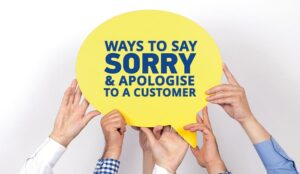A good customer experience is critical in maintaining a steady and satisfied customer base. Problems will inevitably happen, which is why it is vital to ensure that your complaints resolution procedures are robust.
Jane Langan and Derek Bishop explore one of the most difficult aspects of complaints resolution – how to recover from giving incorrect advice.
If you have a situation where information has been given out incorrectly then you have an opportunity to learn and develop. This will help you to ensure the problem does not recur and to gain the customer’s confidence and manage their expectations.
You will have two areas which need to be managed:
- The customer’s expectations and needs
- The employee’s knowledge
James Joyce said, ‘A man’s errors are his portals of discovery’.
(For this I am going to call the customer, John and the employee, Billy).
John may not realise that he has been given wrong information. Should Billy leave it and hope for the best? No, of course not.
John is always going to find out; it is just a matter of time. Imagine how John will feel when he does find out that the information he has been given is incorrect.
John is probably going to be angry, disappointed and feel like he has wasted his time. This is going to put your company at risk because John is going tell his friends – we love to talk about bad experiences, and those friends will tell their friends and so on…
Your reputation as a company will be put at risk and your customer base could reduce.
Alexander Pope said, ‘At ev’ry word a reputation dies’. These are wise words indeed.
So what can we do to recover from the situation?
Step 1 – Helping the employee (Part 1)
Talk to Billy: What happened? Why did it happen? When did it happen? How did it happen? What can we do to stop this occurring again?
Collate the details of the inaccuracy and assess it.
The first step is then to resolve the issue with the customer.
So we must, initially, give Billy the tools to resolve the situation with John and support him through it. We must ensure that Billy is confident doing this and that we are comfortable that Billy can complete this effectively.
We need to make certain that Billy is prepared for all eventualities.
What if John is really angry?
What if John wants to take the issue higher?
What if John wishes to lodge a formal complaint?
Does Billy know how to deal with all of these possible outcomes?
Step 2 – Helping the customer
How can we turn the situation around with John?
We have established exactly what has happened by discussing and assessing the situation with Billy.
Above all else, we need to restore John’s confidence, so the quicker we identify the error, take responsibility and resolve the situation, the better.
We need to decide on best next steps with John, and this should be a two-way street and will depend on what John wants, what sort of person he is and what we can do to resolve the situation.
Should you get Billy’s line manager to call John or do you get Billy to call?
If the line manager calls it shows we take this very seriously and we are aware of what has happened.
If Billy calls, it will help John to feel that he is getting a good service from Billy and will be a step forward in re-building the trust in the customer relationship. Similarly, if Billy makes the call, he shouldn’t feel undermined by his line manager which should build his confidence. If John still wants to talk to Billy’s line manager for reassurance, that’s OK too, but if you have given Billy the support and training to manage the situation this shouldn’t be necessary.
However, this does depend on the severity of the situation and the impact of the incorrect advice.
Whoever makes the call, they should immediately apologise, explain what has happened and then give him the correct advice.
They will need to reassure John that we have taken steps to ensure this doesn’t happen again and explain exactly what those steps are.
Ideally, Billy will explain what has happened and what we/he has done to resolve it; if at all possible Billy will take action to go the extra mile. This should make John feel valued and remove any concerns that may have been raised by the initial error, so that when John tells the tale of this experience it will be under the heading of Great Customer Service.
Step 3 – Future planning
Helping the employee (Part 2) and the customer
Does Billy need additional training?
Was there an issue with the data Billy referred to, is it out of date, or incorrect?
Does Billy find it hard to concentrate because of an environmental factor? For example, an air conditioning unit blowing cold air constantly onto his neck, is it too noisy, is he uncomfortable at his desk, in his chair, etc? Is there anything you can do to resolve the problem?
Is Billy bored? If so, Billy is not focused (and possibly stressed), how can we alleviate the boredom? Is there anything more challenging we can ask him to complete?
Has Billy got too much to do? If so, Billy is struggling to focus on one thing. Do we need to reduce his work load or look at offering some time and work management training?
Once you have found out where the problem lies (and it may be more than one of the above suggestions) then you will need to set clear, realistic timescales and actions to ensure that the appropriate steps are made to resolve the problem.
If it is the technology or information error this is easily resolved and can be dealt with quickly. If it is an underlying personal issue it will be a longer and more complex resolution.

Jane Langan
In these cases there are a number of people who you may need support from for Billy. You may need to get your Human Resources team involved, or your trainers. Overall, you will need to manage this and maintain Billy’s motivation. There has to be a key message here and it is not a message of blame; Billy has made us aware of a problem, a gap, a risk. Now we are aware of it we can tackle it and without Billy this wouldn’t have happened. Your employees have all the power to make your business effective and efficient, listen to them, learn from your mistakes and your business will be a success.
As Alexander Pope said, ‘to err is human to forgive is divine’.
Jane Langan is Contact Centre Manager at the Solicitors Regulatory Authority (SRA) www.sra.org.uk
When customers are unhappy, it is sometimes easier when there is something external to blame, such as a parcel gone missing or another department didn’t fax through the right paperwork, but giving the wrong advice and being found out leaves little room for manoeuvre.
Once in this situation, the customer could swing either way depending on how effectively and honestly you deal with the matter in hand.
There are two scenarios that I am going to look at today, the first is where the customer spots the fact that incorrect advice has been given before the organisation does.
1. When the customer spots incorrect advice
If the customer spots that incorrect advice has or may have been provided by a call centre agent, the trick is to treat it as a potential complaint and make sure you follow your in-house complaint procedures. Whilst it may not be a full complaint, it will at least be an expression of dissatisfaction with the service which has been provided and this means the customer should be handled sensitively, and it is essential to follow a robust process to ensure the matter is concluded fully and satisfactorily.
This way not only will the issue be resolved with the customer, but any learnings from the incident can be captured and shared through the in-house complaints process.
Like any complaint, it is important to get to the root cause of why incorrect advice has been provided – was it really a mistake by the agent or is there something wrong in the systems, scripts or processes which has led the agent to give incorrect advice.
If the cause is within the systems or processes, then the other dimension to consider is how many other agents will also have given incorrect advice?
Let’s assume that it’s just this agent – reviewing the incident with the agent should seek first to understand what happened, and help the agent to identify with what went wrong and what may have contributed to it. This review may well identify some skills or knowledge gaps which previously were not identified, in which case corrective training/coaching and then monitoring can be implemented to ensure the agent is equipped to resolve these particular customer enquiries accurately in future. Any such action should be captured and documented in the performance review documentation for the agent, so there is full visibility and audit trail of what has happened following the incident.
If, however, the root cause of the incorrect advice is identified as being systems or processes, the issue becomes a lot larger.
An investigation needs to take place into how long this has been incorrect, how many customers may have been affected, etc. This then leads on to proactive action being required, as discussed later for instances where the business spots the error in advice before the customer does.
Whatever the corrective action identified and put in place, it’s important to share this with the customer to provide reassurance that you’re not just fixing this individual incident but that you have investigated properly and that action is being taken to minimise the risk of incorrect advice being given to other customers in future. This demonstrates integrity and concern to the customer.
In discussing with the customer, make sure you empathise with them about the impact the incorrect advice may have had on them and suitably apologise. It is also worth asking the customer what they need in order to overcome the situation from their viewpoint. What corrective action would they like, what compensation might they be seeking (if any) – the art is in asking the questions in the right way that leads the customer to determine what should happen – in most instances the customer will be less demanding and seek less compensation (if justified) than you might have expected.
If incorrect advice has been given as part of a sales call, then it is vitally important to deal with the issue straight away. Of course, in some instances, e.g. financial services, the regulator will be expecting proactive resolution of the incorrect advice.
There is a judgement to be made about who should resolve the incident with the customer. If the agent is suitably trained and prepared for the discussion with the customer, then the agent phoning to resolve the matter demonstrates to the customer that they are taking responsibility for their mistake.
However, to demonstrate that the issue has been taken seriously by the business, it may be deemed suitable for a more senior person to be involved in resolving the situation with the customer. This is a judgment call based on the severity of the incident and how you feel the customer may respond, plus how confident you feel in the agent being able to resolve the situation satisfactorily.
If the resolution of the incident is going to take a while, make sure you keep the customer informed throughout the process – again treating it as a complaint and proactively communicating with the customer will help appease the situation.
In all of the investigations it is important to understand the customer’s viewpoint – it may well be that there are two sides of the story and some contributory factors from the customer which led to the incorrect advice being given.
2. If the business spots the incorrect advice before the customer does
In this situation all these same principles should apply, but let’s be honest, some may think, well, let’s see if the customer spots it and then we’ll deal with it at that time.
My guidance would be to be proactive about it. If you’ve identified the issue, communicate with the customer about it immediately, don’t sit and hope for the best, as the consequences of the customer complaining at a later date will be significantly more than if dealt with at the time of spotting the issue.
Here’s an example of where incorrect advice was provided and the whole situation was handled poorly:
A mobile broadband data card was purchased for a Windows Vista machine.
The first data card didn’t work, so the customer contacted the helpline service and checked that the card could be used with a Vista machine. The agent confirmed yes, and said that they would issue a new data card as perhaps it was faulty. This happened three times until a correct answer was obtained – the card would not work with a Vista machine. But even then the agent did not correctly close down the accounts and refund the charges, it took the customer to submit a formal complaint letter before appropriate action was taken.

Derek Bishop
Had the first agent confirmed that the data card would not work with Vista, yes the customer would have gone elsewhere for their purchase, but that’s what happened in the end anyway. What happened in the meantime was there was a huge amount of wasted time and costs for the organisation (and the customer), plus the customer now has a very poor view of the mobile telecoms provider so is highly unlikely to purchase any products/service from them in the future. In such an instance, the damage done is much greater than just the one incident.
In reality, any issue which results in customer dissatisfaction should be treated as a complaint and steps taken to investigate, rectify and record the incident to prevent it happening again. With the increasing exposure of unhappy customers via web forums and reviews, consistently incorrect advice is an issue that organisations can no longer afford to ignore.
Derek Bishop is director of Abeo Consulting
Author: Jo Robinson
Published On: 27th Jan 2010 - Last modified: 6th Jul 2018
Read more about - Call Centre Management, Complaints, CX, Staffing, Training










































At what point do you conclude that “Billy” might just be a bad egg? We have a “Billy” that uses all of those reasons why they constantly deliver poor information (outdated material, too much work, environment, etc), and we’ve adjusted as much as we can, and it still doesn’t help. Is it safe to conclude that its just him?
My seniors are “billys” when it comes to obtaining the correct information
I’d say Billy becomes a bad egg after giving several chances, going through a PIP and not improving MoM, at this stage it will be time to make final decisions. Always better to investigate then make decisions. Amazing article, thanks so much